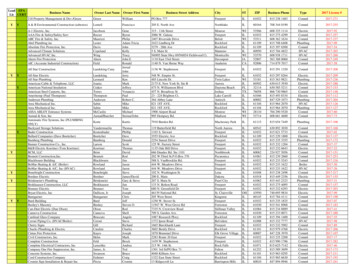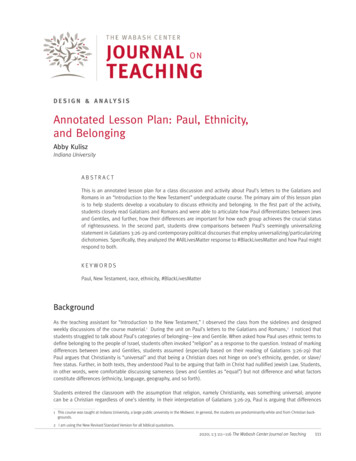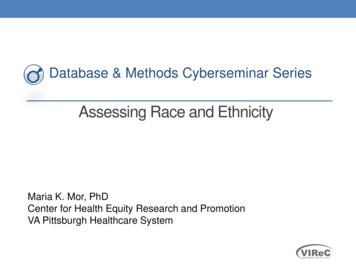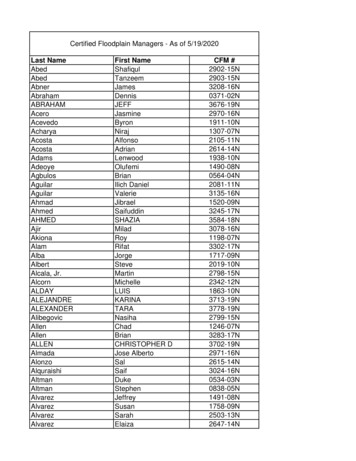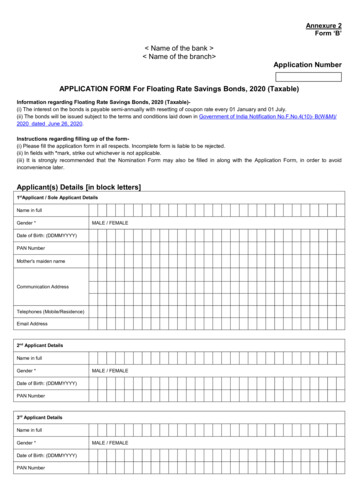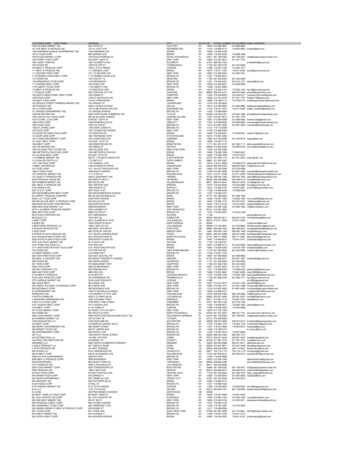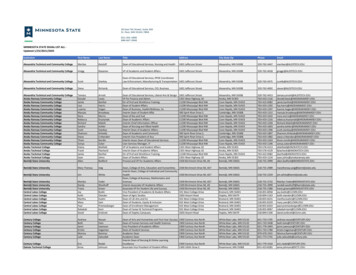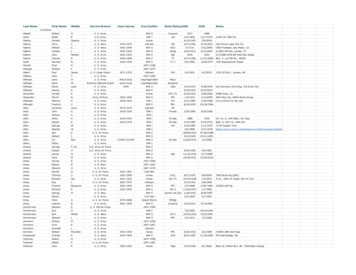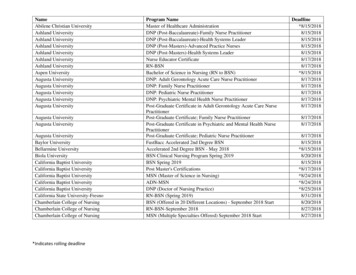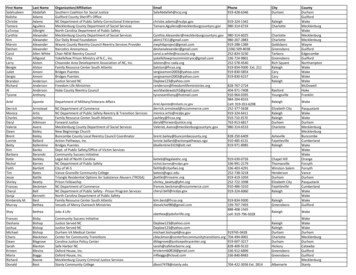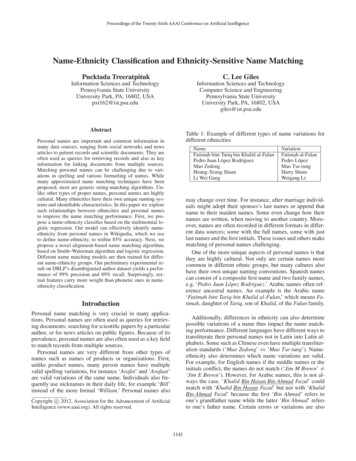
Transcription
Proceedings of the Twenty-Sixth AAAI Conference on Artificial IntelligenceName-Ethnicity Classification and Ethnicity-Sensitive Name MatchingPucktada TreeratpitukC. Lee GilesInformation Sciences and TechnologyPennsylvania State UniversityUniversity Park, PA, 16802, USApxt162@ist.psu.eduInformation Sciences and TechnologyComputer Science and EngineeringPennsylvania State UniversityUniversity Park, PA, 16802, USAgiles@ist.psu.eduAbstractTable 1: Example of different types of name variations fordifferent ethnicitiesPersonal names are important and common information inmany data sources, ranging from social networks and newsarticles to patient records and scientific documents. They areoften used as queries for retrieving records and also as keyinformation for linking documents from multiple sources.Matching personal names can be challenging due to variations in spelling and various formatting of names. Whilemany approximated name matching techniques have beenproposed, most are generic string-matching algorithms. Unlike other types of proper names, personal names are highlycultural. Many ethnicities have their own unique naming systems and identifiable characteristics. In this paper we exploresuch relationships between ethnicities and personal namesto improve the name matching performance. First, we propose a name-ethnicity classifier based on the multinomial logistic regression. Our model can effectively identify nameethnicity from personal names in Wikipedia, which we useto define name-ethnicity, to within 85% accuracy. Next, wepropose a novel alignment-based name matching algorithm,based on Smith–Waterman algorithm and logistic regression.Different name matching models are then trained for different name-ethnicity groups. Our preliminary experimental result on DBLP’s disambiguated author dataset yields a performance of 99% precision and 89% recall. Surprisingly, textual features carry more weight than phonetic ones in nameethnicity classification.NameFatimah bint Tariq bin Khalid al-FulanPedro Juan López Rodrı́guezMao ZedongHeung-Yeung ShumLi Wei GangVariationFatimah al-FulanPedro LópezMao Tse-tungHarry ShumWeigang Limay change over time. For instance, after marriage individuals might adopt their spouses’s last names or append thatname to their maiden names. Some even change how theirnames are written, when moving to another country. Moreover, names are often recorded in different formats in different data sources; some with the full names, some with justlast names and the first initials. These issues and others makematching of personal names challenging.One of the more unique aspects of personal names is thatthey are highly cultural. Not only are certain names morecommon in different ethnic groups, but many cultures alsohave their own unique naming conventions. Spanish namescan consist of a composite first name and two family names,e.g. ‘Pedro Juan López Rodrı́guez.’ Arabic names often reference ancestral names. An example is the Arabic name‘Fatimah bint Tariq bin Khalid al-Fulan,’ which means Fatimah, daughter of Tariq, son of Khalid, of the Fulan family.IntroductionPersonal name matching is very crucial in many applications. Personal names are often used as queries for retrieving documents; searching for scientific papers by a particularauthor, or for news articles on public figures. Because of itsprevalence, personal names are also often used as a key fieldto match records from multiple sources.Personal names are very different from other types ofnames such as names of products or organizations. First,unlike product names, many person names have multiplevalid spelling variations, for instance ‘Arafat’ and ‘Arafaat’are valid variations of the same name. Individuals also frequently use nicknames in their daily life, for example ‘Bill’instead of the more formal ‘William.’ Personal names alsoAdditionally, differences in ethnicity can also determinepossible variations of a name thus impact the name matching performance. Different languages have different ways totransliterate their personal names not in Latin into Latin alphabets. Some such as Chinese even have multiple transliteration standards (‘Mao Zedong’ ‘Mao Tse-tung’). Nameethnicity also determines which name variations are valid.For example, for English names if the middle names or theinitials conflict, the names do not match (‘Jim M Brown’ ‘Jim E Brown’). However, for Arabic names, this is not always the case. ‘Khalid Bin Hasan Bin Ahmad Fazul’ couldmatch with ‘Khalid Bin Hasan Fazul’ but not with ‘KhalidBin Ahmad Fazul’ because the first ‘Bin Ahmad’ refers toone’s grandfather name while the latter ‘Bin Ahmad’ refersto one’s father name. Certain errors or variations are alsoc 2012, Association for the Advancement of ArtificialCopyright Intelligence (www.aaai.org). All rights reserved.1141
to our name-ethnicity classifier. Both their and our approachbreak down each name into smaller units of character sequences, which allow the models to make ethnicity prediction on names that they have not seen before. However, theirapproach only models sequences of characters in differentname-ethnicities, while ours utilizes both phonetic and character sequences.more common in some name ethnicities than others. Chinesenames are often mistakenly reversed (‘Lee Wang’ ‘WangLee’), for a variety of reasons. It is more common to drop thelast name in Spanish names (out of the two lastnames), thanin English names (‘Pedro Juan López Rodrı́guez’ ‘PedroLópez’).While various personal name matching methods havebeen proposed (Christen 2006), most are generic and culture or ethnicity independent. Others are too specific and arespecially designed to work with specific name ethnicities. Inthis paper we explore the relationships between ethnicitiesand personal names to improve the name matching performance. For this work, we consider a name-ethnicity classas a nationality category or a collection of nationality categories given to that name in Wikipedia. For more detail seethe Name-Ethnicity Classification section.This work has three main contributions. First, we presenta novel name-ethnicity classifier based on the multinomiallogistic regression. Our classifier identifies ethnicity of eachname based on its sequences of alphabets and sequences ofphonetics sound. Second, we extend the Smith-Watermanalignment algorithm to take into account various characteristics found in personal name matching. Third, we proposean ethnicity-sensitive name matching method, by combiningour name-ethnicity classifier with our name alignment algorithm, where different costs are placed on different types ofmisalignments depending on the ethnicity of the names being compared.Name Matching Much work has been done on namematching in the domain of information integration, recordlinkage and information retrieval (Bilenko et al. 2003;Christen 2006). Most of the previously proposed techniquescan be categorized into two categories: phonetic-based andedit distance-based. The phonetic-based approaches converteach name string into a code according to its pronunciation, which is then used for comparison (Raghavan and Allan 2004). The edit distance approaches define a small number of edit operations (e.g. insertion, deletion and substitution), each with an associated cost. The distance betweentwo names is then defined to be the total cost of edit operations required to change one name into another. Jaro measures the similarity based on number and order of charactersshared between names. Jaro-Winkler then improves on Jarodistance by emphasizing matches of the first few characters.Other notable flavors of edit distance used in name matching include Levenshtein distance and Smith-Waterman distance (Freeman, Condon, and Ackerman 2006). An excellentreview of commonly used name matching methods can befound in (Christen 2006). Recently, (Gong, Wang, and Oard2009) propose a transformation based approach, where theycompute the best transformation path between names basedon three types of operation: abbreviation, omission and sequence changing. SVM is then used to learn the final decision rule. Their approach is somewhat related to our namematching method. Both attempt to find a mapping betweentwo names; for them, it is the best transformation path using a graph-based algorithm, and for us, it is the optimalalignment through an alignment algorithm. However, theirapproach assumes universal cost for each type of transformations, while our cost function depends on the ethnicity ofthe names.Related WorkName-Ethnicity Classification The ethnicity of a personis an important demographic indicator used in many applications including target advertising, public policy, and scientific behavioral studies. However, unlike names, ethnicinformation is often unavailable due to practical, politicalor legal reasons. Thus, especially in biomedical research,name-based ethnicity classification has gathered much interest (Coldman, Braun, and Gallagher 1988; Fiscella andFremont 2006; Mateos 2007; Gill, Bhopal, and Kai 2005;Burchard et al. 2003). The primary used method in ethnicity classification is to compare to existing name lists.(Coldman, Braun, and Gallagher 1988) use a simple probabilistic method based on full name lists to identify peoplewith Chinese ethnicity. (Gill, Bhopal, and Kai 2005) combine surname analysis with location information to betterinfer ethnicity from names. The drawback of such dictionary approaches is that it cannot classify names which donot appear in the training data and constructing such a dictionary is often difficult. Furthermore, existing dictionariesoften do not have desired granularity of ethnic groups. Forinstance, US Census data only contains six broad ethnicity categories: Caucasian, African American, Asian/PacificIslander, American Indian/Alaskan Native, Hispanic, and‘Two or more races’. More recently, (Chang et al. 2010)train a graphical model based on US Census names to inferethnicities of Facebook users from names and studied theinteractions between ethnic groups. (Ambekar et al. 2009)use Hidden Markov Model and decision trees to classifynames into 13 ethnic groups. This work is the most similarName-Ethnicity ClassificationIn this section, we describe the process we use to collecta list of names and the features used in our name-ethnicityclassifier.Extracting Names from WikipediaInspired by (Ambekar et al. 2009), we take advantage ofWikipedia and their categories as the source for collectingpersonal names of different ethnicities. To cultivate a list ofpersonal names for a given nationality, we use the followingprocedure. First, for each target nationality N , we pick theWikipedia category N people as the root node. We then employ BFS to transverse all subcategories and pages reachablefrom the root node up the the depth of 4. Simple heuristicsis used to restrict the link transversals. For example, we onlyinclude subcategories whose titles contain the word ‘people’ or ‘s of ’ (eg. ‘Members of the Institut de France’) or1142
Table 2: Name-Ethnicity data gathered from 815,15419,58010,38517,7903,750859215,672Table 3: Example of features used in Name-Ethnicity classifierWikipedia CategoriesEgyptian, Iraqi, Iranian,Lebanese, Syrian, TunisianIndianBritishFrenchGermanItalianColumbian, Spanish, ench people French people by occupation French entertainers French magicians Alexander HerrmannThe leaf nodes resulting from such transversal are then collected as personal names for that nationality. Note that neither our heuristics nor Wikipedia categories are perfect. Forinstance, names under ‘British people of Indian descent,’which are of Indian ethnicity, will be filed under Englishnames. Non-personal names could also be included. For instance, musical group names such as ‘Spice Girls’ is included because it is under ‘British musicians’. Thus, we alsomanually curate the resulting name lists, removing any suchobvious missassignments as best as we could.In the end, we gather a total of 215,672 personalnames (after curation) from 19 nationalities, which are thengrouped into 12 ethnic groups as shown in Table 2. Personal names of Egyptian, Iraqi, Iranian, Lebanese, Syrianand Tunisian are grouped together as Middle Eastern names(MEA) and names of Spanish, Columbian, Venezuelan aregrouped together as Spanish names (SPA).Name-Ethnicity Classifier and FeaturesWe then train a multinomial logistic regression classifier toidentify ethnicity of different names based on characters andphonetic sequences. The intuition is that names of differentethnicity have identifiable sequences of alphabets and phonetics. The multinomial logistic regression is a logistic regression that is generalized to more than two discrete outcomes. In a multinomial logistic regression, the conditionalprobabilities are calculated as follows:P r(Yi yk Xi ) 1 T1 K 1l 1 exp(βl,0 βl ·Xi )exp(βk,0 βkT ·Xi ) K 11 l 1 exp(βl,0 βlT ·Xi )StringPedro López pedro lopez dmpNgram PTR LPS soundexP360 L120 Featuresó p, pe, ed, . (2gram) pe, ped, . (3gram) Pm , PTm , . PTm , PTRm , .P360s , L120sFor the name-ethnicity classification, Yi is the random variable for the ethnicity of the name i and Xi represents the corresponding feature vector. The set {y1 , ., yK } is the set ofK ethnicity classes. The set of coefficients {βl,0 , βl }k 1.Kare estimated by a maximum a posteriori probability (MAP)through iterative process. The normal distribution is used asprior on the coefficients.Our classifier utilizes four types of features: (1) nonASCII,(2) charNgram – character ngrams, (3) dmpNgram – DoubleMetaphone ngrams and (4) Soundex. The nonASCII featuresconsist of non-ASCII characters (such as ‘ä’, ‘é’) present inthe name. The charNgram features are character bigrams,trigrams, and four-grams of the n
a list of names and the features used in our name-ethnicity classifier. Extracting Names from Wikipedia Inspired by (Ambekar et al. 2009), we take advantage of Wikipedia and their categories as the source for collecting personal names of different ethnicities. To cultivate a list of personal names for a given nationality, we use the following procedure. First, for each target nationality N .
